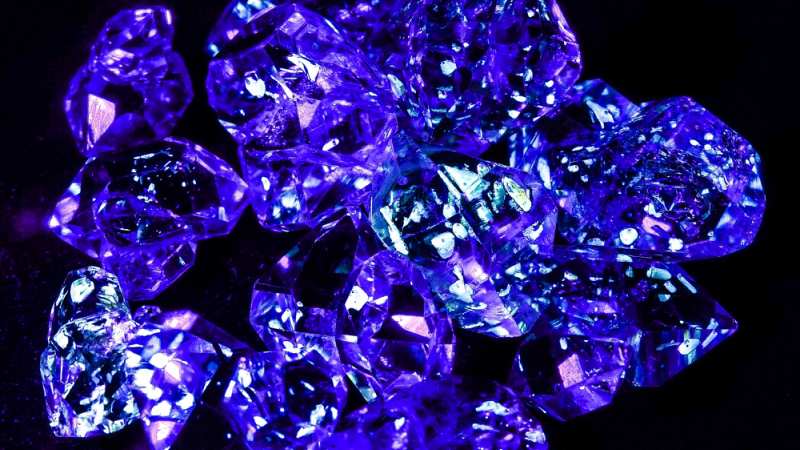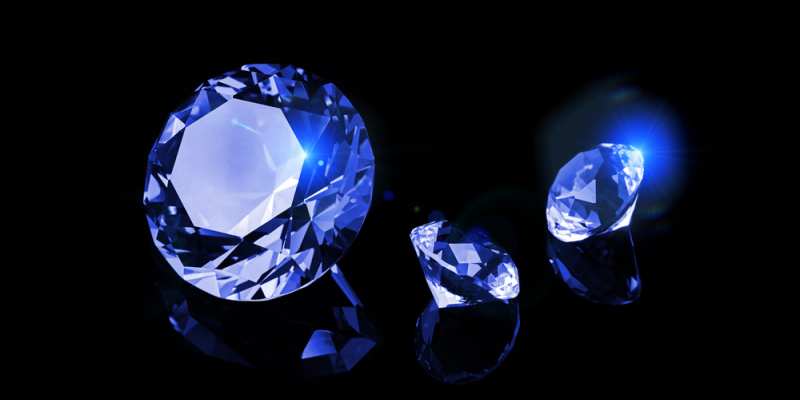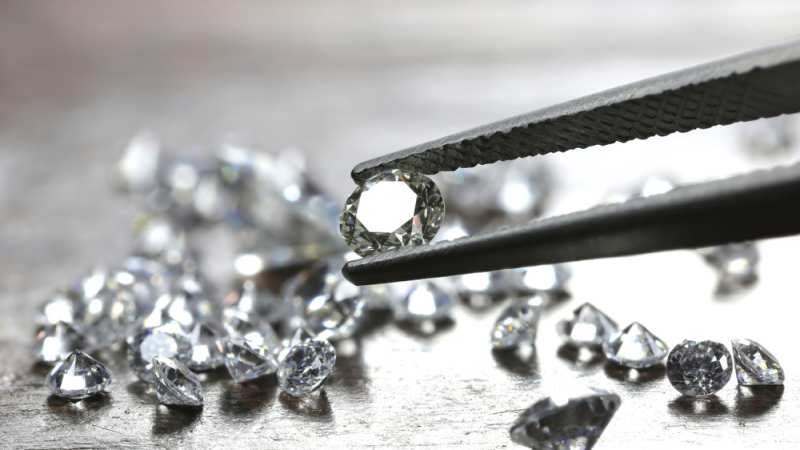When it comes to diamonds, there are well-known characteristics like clarity, cut, carat weight, and color that often come to mind. However, there are lesser-known but equally important features that deserve attention.
One such characteristic is diamond fluorescence, which may not be as familiar to everyone. Just like luminescence in the animal kingdom, diamonds can also exhibit a glowing effect. Surprising, isn’t it? This leads to the question: What exactly is diamond fluorescence?
In this comprehensive article, we delve into the details of this fascinating phenomenon and explore its impact on other aspects of gemstones. Additionally, we share some useful tips and tricks for leveraging this knowledge.
So, let’s not waste any more time and dive right into the captivating world of diamond fluorescence!
DESIGN YOUR OWN ENGAGEMENT RING: START WITH A SETTING OR START WITH A DIAMOND. IT’S REALLY UP TO YOU!

What Is Fluorescence And How Long Does It Last?
Fluorescence is a natural phenomenon that can give certain diamonds a unique glow. When visible light photons excite the atoms within a diamond, they reemit the light almost instantaneously, typically within 10−8 seconds.
Unlike phosphorescence, which requires additional excitation and results in a glow that can last for years, fluorescence is much rarer and occurs in only 0.01% of diamonds. Since the reemission happens quickly, the fluorescence ceases as soon as the light source is removed.
The occurrence of fluorescence in diamonds is due to the presence of various luminescent centers, which are less common in other minerals. This abundance of luminescent centers is a result of the diamond’s unique chemical and physical structure, characterized by a dense carbon atomic network.
Diamonds possess a high atomic density, causing foreign atoms, such as those from light waves, to strongly interact with the lattice electrons. As a result, the diamond electrons undergo energy state changes when excited by light photons, leading to the emission of photons as the atomic particles relax and return to their ground state.
Within these color centers, trace elements or impurities, such as H, He, Ne, Xe, Li, B, N, O, P, Si, Ge, As, Ti, Cr, Ni, Co, Zn, Zr, Ag, W, and Tl, can be found in diamonds, influencing the details of fluorescence.
Several factors contribute to the glowing phenomenon of fluorescence. Diamonds have a large bandgap, which is favorable for luminescence, as energy transitions require both ground and excited states to lie within the bandgap. Diamonds also possess a high Debye temperature, expansive optical transparency window, and excellent luminescence photostability due to their hardness and thermal conductivity.
In terms of colors, diamonds can fluoresce in various hues, most notably blue (approximately 95%), green, yellow, white, or bright yellow.
The glow of fluorescence can be observed using a UV light, offering insights into the nuances of fluorescence and aiding in the identification of diamond jewelry through photographic records. Each diamond’s internal structure is unique, meaning that even pieces from the same stone may exhibit different fluorescent characteristics due to variations in chemical impurities and lattice defects.
Fluorescence can also serve as an indicator of a diamond’s authenticity. Natural diamonds exhibit fluorescence uniformly, while synthetic diamonds may display a criss-cross or hexagonal pattern of fluorescence due to their rapid formation.
Around 30% of natural diamonds are fluorescent, with only 2 to 10% exhibiting intense fluorescence. These diamonds are referred to as Type I, while those without fluorescence are classified as Type II. Research is ongoing to understand the color centers in diamonds, both within the gemological community and the field of nanotechnology.
Certain treatments, such as high-pressure high-temperature (HPHT), can reduce fluorescence in colorless diamonds, which is significant since fluorescence can diminish the value of such diamonds, potentially resulting in discounts of up to 15%.
In the past, diamond color grading was based on the stone’s “true color” as observed indoors under artificial light. However, factors like time of day, geographic location, and cloudiness caused color variations when viewed in daylight. To address this dilemma, scientists established the use of “northern daylight” as the standard for lab-based color grading, which closely resembles the lighting conditions of indirect daylight through windows.
UV lighting has been employed for diamond color grading ever since, as it accurately represents the diamond’s true color. Indoors, diamonds often appear of higher quality, but UV lighting reveals their actual color under daylight conditions.

What Is Fluorescent Grading?
If you’ve delved into diamond quality discussions before, you’re likely familiar with the Gemological Institute of America (GIA). Established in 1931, it is the foremost authority on all aspects related to diamonds, providing research, education, and laboratory services.
The GIA has conducted extensive research on the use of UV versus indoor lighting for diamond grading.
In terms of diamond color, the GIA employs a scale that indicates the gem’s value based on its color intensity. The general rule is that the less color present, the higher the value of the diamond.
The color scale starts with the letter D, representing the highest-valued colorless diamonds, and extends to Z, encompassing diamonds with a slight brownish or yellowish tint. Exploring the intricacies of this scale warrants a separate discussion, which you can find here for a more in-depth analysis.
Additionally, the GIA has established a reputable fluorescence grading scale that is widely used by jewelers and gemologists worldwide. The scale consists of the following categories:
- None: The diamond does not exhibit any fluorescence under UV light. These diamonds are highly valued as they lack any trace elements that would cause fluorescence.
- Faint: A soft blue glow is visible when the diamond is exposed to UV light. This fluorescence is caused by minor trace elements that do not significantly impact the diamond. Diamonds in this category have a similar effect on price as those graded “None.”
- Medium: The diamond emits a light blue glow under UV light. While still offering good value, diamonds in this category may experience a slight reduction in price. Additionally, medium fluorescence can enhance the appearance of lower color grades such as J, K, or L.
- Strong: When exposed to UV light, the diamond displays a deep blue glow. Strong fluorescence can slightly improve the appearance of lower color grades like J, K, or L, but it may have a negative effect on high color diamonds such as D or E, making them appear slightly grayish.
- Very Strong: The diamond exhibits a vivid blue glow under UV light, which can significantly affect its appearance. Diamonds with very strong fluorescence may appear grayish and hazy.
It’s worth noting that the American Gem Society (AGS) employs a slightly different fluorescence grading scale, combining “None” and “Faint” categories as negligible. So, you may come across this alternative scale as well.

Is Diamond Fluorescence Good Or Bad?
The jewelry industry has yet to provide a definitive answer to this question, as the impact of fluorescence on a diamond’s value can vary. It depends on factors such as the specific diamond, the subjective opinion of experts, and current trends in the market.
However, there are certain scenarios where fluorescence can influence a diamond’s value. If a diamond exhibits such strong fluorescence that it appears hazy, oily, or cloudy, it may decrease in price when assessed by a reputable jeweler. This is because the diamond’s ability to refract light properly can be compromised in such cases.
It’s important to note that there are other reasons why a diamond can become cloudy, but delving into those details is beyond the scope of this discussion. We have a separate guide that covers this topic, should you wish to explore it further.
Some geologists believe that fluorescence contributes to the uniqueness of a diamond. However, significant haziness resulting from fluorescence is relatively uncommon. In other instances, fluorescence can make a diamond’s body color appear whiter, giving the impression of a more expensive gem.
For example, if you choose an “F” colored diamond that exhibits intense fluorescence, although it may not be colorless, it can create the illusion of being a high-priced, clear, colorless diamond. This mainly applies to diamonds that fluoresce blue. Conversely, for diamonds that possess a yellowish hue when they fluoresce, the effect is the opposite. However, if a yellow-colored diamond exhibits a blue glow, it can appear lighter and consequently command a higher price.
That being said, it is generally recommended to focus on the four Cs—color, clarity, carat, and cut—since fluorescence typically has minimal impact and is considered negligible in most cases.

Does Diamond Fluorescence Affect Value?
As mentioned earlier, fluorescence can impact the color and, in some cases, the clarity of a diamond, and it can also have an influence on its price. However, it’s important to keep in mind that a diamond with some fluorescence, when viewed without UV light, is essentially the same as a diamond without fluorescence.
It is advisable to have an expert examine the diamond, as the price can vary depending on the jeweler’s experience in detecting subtle differences. If you are purchasing a diamond online, it is recommended to view the piece in person, as the potential visual effects may not be listed in the gem’s description.
Diamonds with and without fluorescence: Can you spot the difference? A study conducted by GIA on fluorescence revealed that the strength of fluorescence typically has no visible effect. In fact, the average person is unable to distinguish between a diamond that fluoresces and one that does not, unless viewed under UV light.
Therefore, if you are concerned about fluorescence affecting the overall appearance of your diamond, rest assured that most people will not be able to perceive any difference.

Conclusion
By now, you should have a good understanding of diamond fluorescence and what to consider when visiting a jewelry store. Here’s a quick recap of the key points we’ve discussed:
- Request a fluorescence check in addition to reviewing the certificate when buying a diamond. It’s important to know the actual quality and appearance of the gem before making a purchase.
- It’s not uncommon for the stones in a jewelry piece to display varying levels of UV-induced fluorescence. Only a small percentage of diamonds exhibit consistent fluorescence.
- If you’re working within a budget, opting for a lower color quality diamond that exhibits more fluorescence can be a smart choice. The typical blue glow tends to mask any color discoloration in the diamond’s body better than other types of fluorescence.
- Remember that fluorescence is primarily an identifying characteristic of a diamond and is neither inherently good nor bad. It’s subjective and depends on personal preference and the specific characteristics of the diamond.
Now that you have a clear understanding of the impact of fluorescence, you can make a more informed decision when purchasing a diamond.


